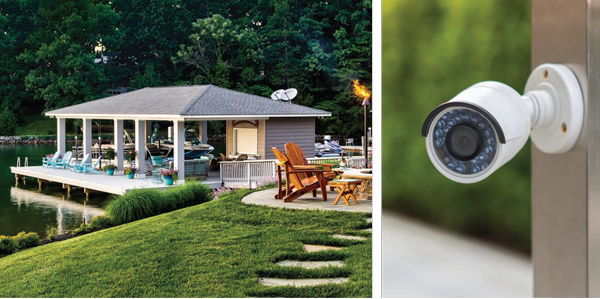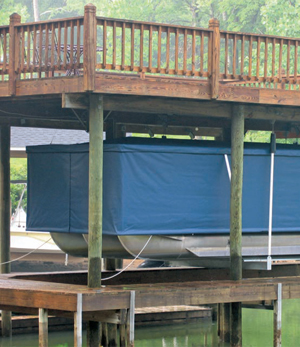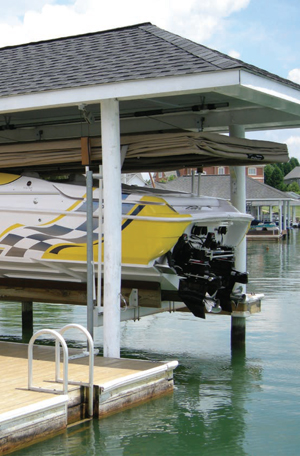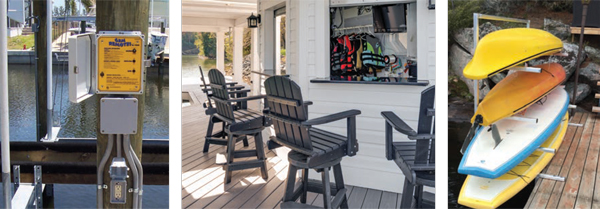
Photography by Craig Shaffer
Shorefront property owners at Smith Mountain Lake are dressing up their docks with both high-tech and time-tested accessories to facilitate use and storage of watercraft and their collections of toys for on-the-water fun.
 Easy boat covering
Easy boat covering
One significant innovation in boat keeping is the “automatic” or “touchless” boat cover. Introduced to Smith Mountain Lake by installing dealer Jay Shoffner in 2005, these custom-measured and -crafted waterproof fabric cocoons are raised and lowered by remote to fully shield runabouts, pontoons, fishing boats and water sports towboats from rain and snow, damaging UV rays and insect droppings. Boat owners love them for the time and energy they save keeping their watercraft shipshape. “Purchasers tell us they use their boats much more when they are spared the inconvenience of manually uncovering and recovering their boats, and that they enjoy the outings more when boats are clean and inviting,” says Shoffner. “Then there’s the safety factor: As boat owners age, manhandling canvas and crawling around to fasten and unfasten snaps gets increasingly difficult and precarious.”
Case in point: Lakewatch Plantation boater John Stroebel found that handling the mooring cover for his new wake boat was time-consuming and taxing, especially working alone. One evening, while fitting the cover around the boat’s complex towing tower, he slipped and tumbled, whacking his head on the dock and losing a $700 pair of prescription sun glasses. “That was the last straw,” Stroebel says, and is finding his new automatic boat cover to be the ideal way to safely and easily keep his boat looking showroom-pristine.
Automatic boat covers are pricey; they can run $8,000 to upwards of $14,000, depending on boat size. But owners feel they are worth the price for convenience, safety and maintaining vessel resale value. Over 500 have been installed on SML docks to date.
 More fingertip control
More fingertip control
Boat lift remotes are a nice convenience and can replace oldstyle pole-mounted switches for about $620 per lift, says Bill Nissan of Dock Solutions. “A remote lets the skipper, returning after a half-day cruise, reposition the lift to account for water level changes,” he says. “During low-water periods, operators can board and disembark at dock level, lowering and raising the lift from the helm seat. And use of a button-hold remote precludes the accidental turn-ons or over-runs that happen with old-style lift switches, resulting in costly repairs to boats, lift cables and dock ceilings.”
Flat-panel smart TVs are another popular dock feature, remotely controlled for easy changes between sports, YouTube, HGTV and Netflix. Some rely on a cable feed for reception but, says Matt Hartberger of Roanoke’s Audiotronics, “A wireless signal for TV, iPad or laptop from a house-mounted outdoor access point can transmit up to 500 feet, depending on obstructions.”
Hartberger also notes increasing call for TVs designed for outdoor locations. He sells a flat-screen model that can get hot, cold, splashed and rained on or even hose washed with no damage; a 55-inch model runs around $2500. Also, exterior audio system speakers are now designed to be hidden from view and direction-focused to minimize sound carry over the water, Hartberger says.
For security, Audiotronics offers alarm and surveillance systems from simple to deluxe. Today’s recorders can store video to the cloud or transmit real time images to smartphones and iPads for monitoring when owners are away.

Storage that saves dock space
With the recent popularity of paddle boards and kayaks, storing them in ways that minimize the fixed dock or floater space they occupy is important. Racks that keep boards on edge, against a dock house wall, between pilings or even on the deck, can be purchased or duplicated with PVC tubing. Because docks vary so widely in their design, orientation and use patterns, no one system fits all. Those looking for a storage solution might consider cruising the coves, taking note of how other dock owners have corralled their paddle-craft between uses. Most owners will gladly talk about their solutions if you catch them lounging on their docks. Cellphone photos of appealing approaches can provide good guidance for DIY adaptations or work by a hired handyman or dock builder. The same scouting approach can also turn up tow-tube storage ideas such as pulley systems that raise towables into dock rafters.
THINKING THROUGH HOW YOU WISH TO USE YOUR DOCK AND TAKING STEPS TO PREPARE FOR THOSE OCCASIONS WILL MAKE LAKEFRONT LIVING MORE ENJOYABLE FOR ALL.
Tried and true convenience
Some simple approaches stand the test of time. A container or rack for swim noodles can keep them orderly, ready to be quickdrawn from their quiver by swimmers about to take the plunge. Find a place in the dock house to store life jackets on clothes hangers. A simple closet pole or wire shelf usually works to keep them hanging orderly and free to air dry after use.
Fenders permanently affixed to your floater (keep them above-water to avoid mildew and slime!) and “guest” docking lines make short-term tie-ups easy for you and friends who stop by. Outdoor carpeting—Lowe’s offers some made from recycled plastic soda bottles—improves footing on floaters, protects from sun weathering, and keeps decking splinter free and cool under foot. A newer solution: WEARDECKTM, a just-introduced durable HDPE-over-fiberglass decking alternative, comes in eight colors that reflect UV rays and stay cool to the touch of tender feet.
Swim ladders are a must for enjoying SML’s cooling waters, and an updated design called “Clean Ladder” rotates up out of the water to keep scum from forming on steps. Plus, its wide, sloped steps are easy for children and elders to climb. Dock Solutions can install one on your floater for $199.
Thinking through how you wish to use your dock and taking steps to prepare for those occasions will make lakefront living more enjoyable for all. And since dock owners and their guests age into different use phases as years pass, designing the ideal dock is not “once and done.” Evolving needs suggest evolving solutions to best fit how a dock is being used each summer, and updates to equipment and storage solutions should be ongoing. ✦
